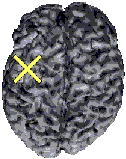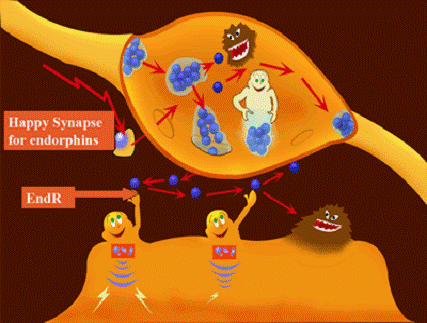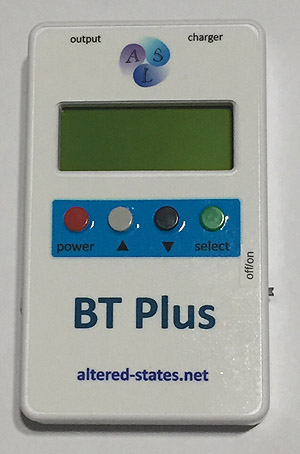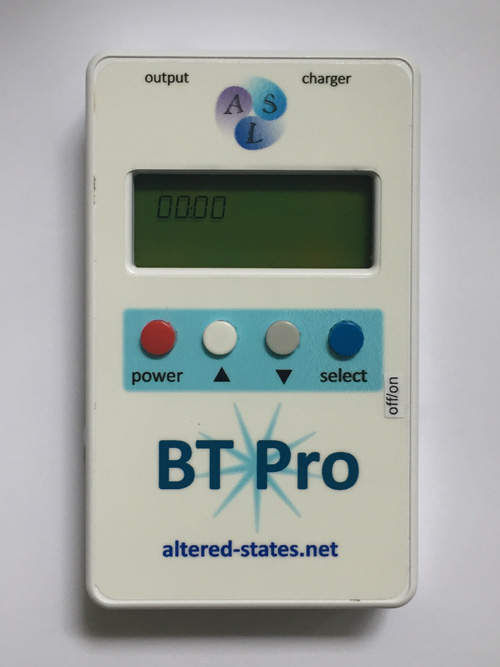Not only are endorphins thought to block the sensation
of pain, but they also work to lower stress levels
and support the immune system. Some studies have
indicated that they can cause certain cells,
called natural killer cells, to be triggered.
Once those cells are stimulated, they work to
fight cancer cells. As a result, some researchers
believe that chemicals may be used to lower the
likelihood of developing cancer or to help fight
the disease."
Endorphins belong to a class of biochemicals commonly referred to as
neurohormones that act by modifying the way in which nerve cells respond
to transmitters. The discovery of this class of biochemicals has an unusual
and interesting history. In the 1960s, biomedical researchers studying
the causes and effects of opium addiction had detected what they suspected
were "opiate receptors" in brain tissue. Since it seemed quite
unlikely that humans (or other vertebrates) would contain a specific
receptor designed for a chemical derived from the poppy plant, the researchers
focused their attention on biochemicals that might be synthesized in
the brain itself. Early in the 1970s, several small peptides were isolated
that appeared to possess natural analgesic properties, and these were
collectively termed enkephalins and endorphins. The modification of neural
transmissions by these biochemicals now appears to be responsible for
the insensitivity to pain that is experienced by individuals under conditions
of great stress or shock. The effectiveness of analgesic opiate derivatives
such as opium, morphine, and heroin is an accidental side effect that
derives from the ability of these substances to bind to neurohormone
receptors despite their very different structure.

| Endorphins control emotions as well. The psychological model
is "Glad, sad, and mad", with fear as a sidebar. The
average person is typically in glad mode. If duress downshifts
them to sad or mad, endorphins are released for re-elevating them
to glad. If fear strikes, endorphins similarly allow coping by
providing a feeling of calm euphoria. Such a nice feeling, perhaps
too nice of one. Your brain (the primal portion) maintains a certain
quota of endorphins to ensure survival under duress. . |
"There isn’t just one kind of endorphin – in
fact, there are at least 20 kinds. One variety
called beta-endorphins has been found to be stronger
than morphine in its effects on the body. This
isn’t an unusual comparison – endorphins
are regularly compared to opiates in regards to
their effects on the body. However, endorphins
have the advantage of being non-addictive, unlike
opiate drugs like morphine and codeine."

| Chocolate-lovers will be delighted to hear
that dark chocolate provides protection against
heart attacks and strokes.NB :)" all
you need to eat to improve your health is 6.7g
per day.
That's equivalent to one small square two or
three times a week" |
Endorphins are most heavily released
in the human body during stressful events or in
moments of great pain. The rush of endorphins into
the system
at such times is often felt as a queasy or nervous
feeling in the stomach. However, the amount of
endorphins released by individuals varies so that
an occurrence that stimulates significant neurohormone
secretion in some
people will not necessarily do so in others. In
addition to stress and pain, endorphin secretion
may be triggered by the consumption of certain
foods, such as chocolate and chili peppers. Indeed,
the characteristic increase in bodily endorphin
levels caused by chocolate is believed to
play a significant role in its often being turned
to as a comfort food in times of stress. Moreover,
due to the endorphin release associated
with chili peppers, they have been utilized in
various kinds of medical treatments, especially
as part of therapy for chronic pain, and are sometimes
considered an aphrodisiac. Certain kinds of physical
activity have been
associated with endorphin secretion in recent years
as well. Undergoing massage therapy or acupuncture,
for example, is believed to stimulate
endorphin release, and the natural painkillers
may be responsible for the euphoric feelings known
as "runner's high" and "adrenaline
rush."
Other actions of endorphins include:
Stimulation of the immune system by the activation
of natural killer cells
Postponement of aging
C.E.S.– EFFECTIVE ALTERNATIVE TO
DRUGS
Endorphins are the body's natural pain medication hormones. Endorphins
(en-dor-fins), when they're released, make us feel better, improve our
mood, increase pleasure, and minimize pain.
"Marathon runners talk of "hitting
the wall," which is experiencing great
pain after pushing the body so many miles.
As the
runner works through this "wall" the
body releases endorphins creating the term, "the
runner's high," which enables them to
sail through the next set of miles."
So how can you harness this natural chemical
and use it to your advantage? |
MUSIC
Biologists have discovered that the emotional richness of music can
give people a sense of euphoria, or 'a high'. "The healing chemicals
created by the joy and emotional richness in music (movie soundtracks,
religious music, marching bands, and drumming ensembles) enable the body
to create its own anesthetic and enhance the immune function." (ME
p. 71) One music study found that half of the expectant mothers who listened
to music during childbirth
did not require anesthesia. It is believed that the music stimulated
endorphin levels and provided a distraction from pain and anxiety . (ME
p 71)
Hospitals and clinics around the world use music
therapy, and not only on their patients! Here are some examples:
(from ME p. 132-133)
When Mulholland’s research was published
it greatly impacted the television industry,
at least in the marketing and advertising sector.
Realizing viewers automatically enter a trance
state while watching television, marketers
began designing commercials that produce unconscious
emotional states or moods within the viewer.
The aim of commercials is not to appeal to
the rational or conscious mind (which usually
dismisses advertisements) but rather to implant
moods that the consumer will associate with
the product when it is encountered in real
life. When we see product displays at a store,
for instance, those positive emotions are triggered.
Endorsements from beloved athletes and other
celebrities evoke the same associations. If
you’ve ever doubted the power of television
advertising, bear this in mind: commercials
work better if you’re not paying attention
to them! Television:
Opiate of the Masses |
In a 1995 study it was found that surgeons who listened to the music
of their choice while operating, were found to have lower blood pressure
and a slower heart rate and could perform mental tasks more quickly and
accurately.
A profesor of music and psychiatry, Dr. Paul Robertson of Kingston Univ.
in Ontario, Canada, shares studies that show that patients who are exposed
to 15 minutes of soothing music require only half the recommended doses
of sedatives and anesthetic drugs for painful operations.
Harp music has been prescribed instead of tranquilizers and painkillers
for cancer patients at the University of Massachusetts Medical Center.
The use of chants, tones, and music have been used to aid a variety of
clients and Alzheimer patients at the University of Louisville School
of Medicine. This Medical center sponsors an Arts in Medicine program
which coordinates with the Department of Psychiatry and Behavior Sciences.
Deaf and hearing-impaired children are "learning to hear" at
a Multisensory Sound Lab developed at the University
of Oklahoma Dept. of Communication Sciences and
Disorders. A floor containing an audio
system amplifies sound and as children sit on it,
it transforms into vibrations that can be felt through
their bodies.There are also light shows, and other displays that
are sensitive to the music, making this an intense experience that has
often helped these children with the development of speech, control of
their voice, and an ability to
hear.
"Try to let go of outmoded, untrue, conceptions
about crying. It is good to cry. It is healthy
to cry. Emotional tears have
special health benefits. Biochemist
and “tear expert” Dr.
William Frey at the Ramsey Medical Center in
Minneapolis discovered that reflex tears are
98% water, whereas emotional tears also contain
stress hormones which get excreted from the
body through crying. After studying the composition
of tears, Dr. Frey found that emotional tears
shed these hormones and other toxins which
accumulate during stress. Additional studies
also suggest that crying stimulates the production
of endorphins, our body’s natural pain
killer and “feel-good” hormones.” Source
|
Effects Of Endorphins
 When
endorphins are produced, they can have a variety
of effects on the body. Some of these effects
include:
When
endorphins are produced, they can have a variety
of effects on the body. Some of these effects
include:
 Blocking pain: Endorphins affect the part of the
brain that controls how you feel pain. When beta-endorphin
was injected directly into the brain, it was 48
times more effective at pain relief than manmade
opiates.
Blocking pain: Endorphins affect the part of the
brain that controls how you feel pain. When beta-endorphin
was injected directly into the brain, it was 48
times more effective at pain relief than manmade
opiates.
 Boosting mood: Endorphins have long been associated
with increased feelings of pleasure. It’s
thought that endorphins help encourage us to do
the things we find pleasurable, including everything
from friendship to exercising to eating food.
Boosting mood: Endorphins have long been associated
with increased feelings of pleasure. It’s
thought that endorphins help encourage us to do
the things we find pleasurable, including everything
from friendship to exercising to eating food.
 Relieving stress: When you’re stressed out,
a boost of endorphins can make you feel more relaxed.
Relieving stress: When you’re stressed out,
a boost of endorphins can make you feel more relaxed.
 Moderating appetite: Part of endorphins’ role
is to let your body know when you’ve had
enough of something.
Moderating appetite: Part of endorphins’ role
is to let your body know when you’ve had
enough of something.
 Enhancing the immune system: Your immune system
can get a boost when endorphins are secreted.
Enhancing the immune system: Your immune system
can get a boost when endorphins are secreted.
 Releasing sex hormones: The production of endorphins
can also trigger the release of sex hormones
Releasing sex hormones: The production of endorphins
can also trigger the release of sex hormones
.By: Ashley Henshaw

CES
Cranial electrical stimulation, and stimulation at selected points of
the peripheral nervous system, have been shown to modulate brain neurochemicals,
such as endorphins, serotonin, ACTH, epinephrine and norepinephrine.
Some of these neurochemicals act as natural morphine-like agents to inhibit
pain, while others raise the pain threshold in a natural manner. Studies
have shown that serotonin, beta-endorphins and ACTH levels have continued
to change up to four hours following treatment. However, the positive
effect of the neurochemical changes on patient pain level has been reported
to last up to 48 hours after treatment.
A recent neurochemical study indicates that beta-endorphin, serotonin
and melatonin increase in plasma and cerebrospinal fluid after a 20-minute
cranial stimulation treatment. (J Neurol OrthopMed Surg (1998) 18:94-97)
There is published
research spanning over 40 years, with at
least 20 double-blind placebo-controlled
studies that prove benefit outweighs risk.4,5
Several studies suggest that cranial electrotherapy
triggers changes in neurotransmitters and
endorphin
release.6,7 http://www.psychiatrictimes.com |
C.E.S.– EFFECTIVE
ALTERNATIVE TO DRUGS
Endorphins are the body's natural pain medication hormones. Endorphins
(en-dor-fins), when they're released, make us feel better, improve our
mood, increase pleasure, and minimize pain.
4 hz releases endorphins, 50 - 200 hz releases
seratonin
Neuro-transmitter |
Function |
Drugs
that Affect
Neuro-transmitters |
Neuro-transmitter
Deficiencies Result In |
Norepinephrine |
Arousal,
energy, drive |
Cocaine,
speed, caffeine, tobacco |
Lack
of drive, depression, lack of energy |
GABA |
Staying
calm, relaxation, focus |
Valium,
alcohol, marijuana, tobacco |
Free-floating
anxiety, fearfulness, insecurity, can't relax
or sleep, unexplained panic |
Endorphins |
Psychological
/ physical pain relief, pleasure, reward,
good / loving feelings toward others |
Heroin,
marijuana, alcohol, sugar, tobacco |
Overly
sensitive, feelings of incompleteness, anhedonia
(inability to experience pleasure normally),
world lacks color, inability to love |
Serotonin |
Emotional
stability, pain tolerance, self-confidence |
Sugar,
marijuana, ecstasy, tobacco |
Depression,
obsession, worry, low self-esteem, sleep
problems, hunger, irritability |
Low endorphin levels make us crave fat
Nan Allison in her excellent book Full & Fulfilled describes the
relationship between endorphins, food, and exercise. By permission, Nan
Allison, M.S., RD writes:
Cranial Electrical Stimulation Potential Use in
Reducing Sleep and Mood Disturbances
in Persons
With Dementia and Their Family Caregivers
High concentrations of endorphins in the brain produce a sense of euphoria,
enhance pleasure, and suppress pain, both emotionally and physically.
When endorphins are low, people feel anxious; they are also more aware
of pain. They have an appetite for fat and fatty foods, such as fries,
cheese, creamy sauces, margarine, butter, fried chicken, potato chips,
and chocolate, to name some of the most popular examples. Upon eating
some fat, they will notice a change in mood, feeling more pleasure. This
feeling is related to a higher concentration of endorphin. Exercise,
by releasing fat from within the body, raises endorphins and causes the
same mood changes.
| Mild Drugs, such as the Caffeine in Coffee, Cola, and Tea,
can produce withdrawal symptoms. People who drink as little as
TWO cups of Coffee or Three Colas per day experience Withdrawal
if they suddenly give up the Habit. The symptoms range from mild
headache to those resembling the flu |
When we have cravings for potato chips and chocolate, it may mean that
we need an endorphin pill rather than all the empty calories from chips.
| ‘It’s a hit’, screams the advertisement
for Coca-Cola. ‘I can see clearly now, the rain has gone’,
goes the song for a Nescaf commercial. ‘Happiness is a small
cigar’, intones the Hamlet voice-over. The craving associated
with thirst and hunger pangs is considered normal, and is well
understood by the fast-food industry. |
|

Smoking
For many people it is love at first puff. Cigarettes contain 4,000+ deadly
toxins including nicotine. A nicotine "high" reaches
the brain within seven seconds. Nicotine, when
first ingested, causes a
person to feel awake and alert, shortly after that
person feels calm and relaxed. This is due to an
elevation in endorphins, which are the
body's natural pain reduction and pleasure chemicals
that are produced in the brain. After time, more
and more nicotine is needed to achieve
the same pleasurable feeling, leaving the smoker
addicted. The usage of this narcotic creates a
roller coaster effect in your system that
is very hard to break free from.
Once you are a habitual smoker, your mind and body develop
a physical dependence for nicotine. Smoking excites your body's pleasure
chemicals, endorphins, and puts them into high gear. This makes you feel
very good - until your body summons you to replenish the depletion of
nicotine in your system. So you smoke again, and again, and again. It
is a vicious cycle that never stops until you quit smoking for good.
NOW
YOU CAN MIMICK THE EFFECT OF NICOTINE AND QUIT
Low dopamine make us feel foggy
Mentally "foggy" at times? This just may be caused
by low dopamine levels. When we don't get adequate protein, dopamine
levels drop and this makes us mentally sluggish.
The best way to raise dopamine levels, get plenty of lean
protein in you diet, with moderate fat and carbs, advises Nan
Allison. |
C.E.S.– EFFECTIVE ALTERNATIVE
TO DRUGS
Endorphins are the body's natural pain medication hormones. Endorphins
(en-dor-fins), when they're released, make us feel better, improve our
mood, increase pleasure, and minimize pain.
My doctor prescribed
narcotics after my accident and now I can't get off them.

So why do you feel so rotten when you try to stop? Narcotics work because
they affect the cells more than your own endorphins do; in response,
your body adapts and tries to return things to normal by reducing the
cells' sensitivity to both the painkilling drugs and the natural endorphins.
That's how what is called tolerance to a particular drug develops.
Transform Your Pain, Anxiety, or Depression for
a boost in Endorphin Levels
The feeling you get when you stop is called withdrawal, and it may be
responsible for most of your woes. Your digestive tract offers a good
example of this process. Opiates slow the movement of material through
the intestine, so it's likely you suffered from constipation at first.
Since you have been taking a painkiller for quite a while, your body
has probably adapted to this retarding effect by speeding things up,
leading to relatively normal bowel function even while you're taking
the drug..

When you stop ingesting the drug, this speeding-up effect remains, but
is no longer balanced by the slowing influence of the drug. The result:
stomach cramps and diarrhea. The other sensations you experience when
you stop -- chills, achiness, flulike symptoms and increased sensitivity
to pain -- arise because many parts of your body have reduced their sensitivity
to your own endorphins. When you feel compelled to keep taking the drug
to avoid the unpleasant effects of withdrawal, you are experiencing a
physical dependence -- which can happen even when you take the drugs
as prescribed by a doctor.Induce euphoria and stop your gut churning,
it may well be that addiction to opiates is just a lack of natural endorphins,
NOW you can produce natural endorphines
Enhance Endorphin Levels
C.E.S.– EFFECTIVE ALTERNATIVE TO DRUGS
Endorphins are the body's natural pain medication hormones. Endorphins
(en-dor-fins), when they're released, make us feel better, improve our
mood, increase pleasure, and minimize pain.
Depression
Over the past 30 years, medical science has learned the
importance of brain chemistry. Previously, depression was thought to
result from problems of living, with a psychiatrist's couch the best
remedy. It is now clear that most victims of depression have something
wrong with their neurotransmitters—decisive brain chemicals such
as serotonin, dopamine, norepinepherine, and the endorphins, all of which
have a powerful influence on intelligence, personality, and moods.

Most psychiatrists resort to powerful brain-altering drugs,
in an attempt to help their patients. However, individual responses to
drug medications are extremely variable and this therapy is more of an
art than a science, with medications administered on a crude trial-and-error
basis.
There is no doubt that prozac, zoloft, risperdal, and other medications
provide benefits to many patients. However, the benefits are usually
quite incomplete and these medications often have serious side effects,
such as blunting of personality, movement disorders, and fatigue. Even
when a medication effectively alters serotonin or dopamine functioning,
as desired by the psychiatrist, the drug may effect other brain chemicals
with adverse effects.
Laughter diminishes the secretion of cortisol and epinephrine,
while enhancing immune reactivity. In addition, laughter boosts
secretion of growth hormone, an enhancer of these same key immune
responses. The physiological effects of a single 1-hour session
viewing a humorous video has appeared to last up to 12-24 hours
in some individuals. |
A well-balanced state of health includes an ongoing
production of endorphins. Babies, toddlers and
children are naturally – given a non-violent
family and culture – endorphinated. Adolescents
and adults tend to lose their natural wellbeing
and tighten up. Adrenalin and cortisol , the
hormones of tension and anxiety begin to
predominate
C.E.S.– EFFECTIVE ALTERNATIVE TO
DRUGS
Endorphins are the body's natural pain medication hormones. Endorphins
(en-dor-fins), when they're released, make us feel better, improve our
mood, increase pleasure, and minimize pain.
BT
Plus CES system |
Its
An Alpha theta Stim and a BT11
all in one
5 Built in frequencies
 0.5
Hz 0.5
Hz
 1.5
Hz 1.5
Hz
 5.0
Hz 5.0
Hz
 7.83
Hz 7.83
Hz
 10
Hz 10
Hz
 100.00
Hz 100.00
Hz
 Plus
the Full BT6-BT11 Beck Protocol Plus
the Full BT6-BT11 Beck Protocol
 1000.00
Hz + 111.00 Hz 1000.00
Hz + 111.00 Hz
 Over
500 Harmonic frequencies Over
500 Harmonic frequencies

|
 Fully
Rechargeable Batteries Fully
Rechargeable Batteries
 Timer Timer
 Intensity
Control Intensity
Control
 Very
portable Very
portable
 High
Quality Ear clips High
Quality Ear clips
|
|
BTPro
All in ONE very Advanced System

 |
Fully
Rechargeable Battery and Charger |
 |
Timer |
 |
Intensity
Control |
 |
Very portable |
 |
High Quality
Ear clips |
 |
Bio
Feedback |
 |
|
 |
Manual |
 |
So
many add on options |
| |
|
|
|
BTPro
RRP $NZ599.95 approx
$US380.00
More
Info
|
|
 |
Extra
High Quality Ear clips
|
|
Extra
TENS Pads
4
Tens pads and lead
All the BT units can be
used as a TENS
TENS
Tips |
|

